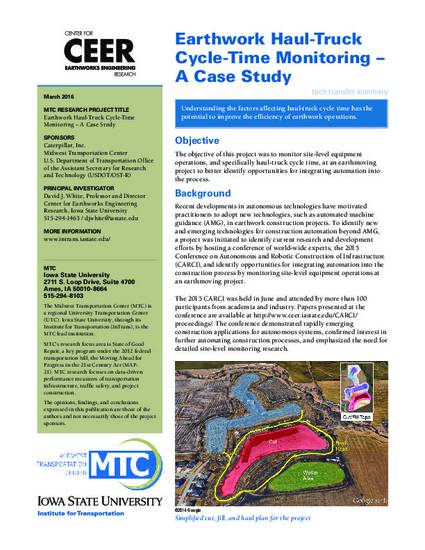
Unpublished Paper
Earthwork Haul-Truck Cycle-Time Monitoring – A Case Study
Tech Transfer Summaries
Document Type
Report
Publication Date
3-1-2016
Disciplines
Abstract
Recent developments in autonomous technologies have motivated practitioners to adopt new technologies in highway and earthwork construction projects. This project set out to (1) identify new and emerging autonomous earthwork technologies and (2) set up a field study to monitor site-level equipment operations at an earthmoving project. The results of the first part of this study are described in a separate report (2015 Conference on Autonomous and Robotic Construction of Infrastructure [CARCI]). The information reported herein presents the results of the site-level monitoring of an earthwork project, where the objective was to quantify haul truck cycle time. The site selected for monitoring was located in Johnston, Iowa, and required grading to build up a residential development. The project involved about 200,000 cubic yards of excavation and placement. Installing a storm sewer and digging a pond were also required for the project. The soils on site were of glacial origin and were generally classified as silty clays. Position tracking devices were installed on the equipment to monitor the time and position of the equipment for several days. Based on statistical analysis (non-parametric) of the haul cycle times for three haul trucks, the results are presented in terms of frequency distributions and accompanying statistical parameters. Recommendations are provided to build on this study so that additional earthwork sites can be evaluated to more broadly quantify the many factors affecting earthwork productivity.
Sponsors
Midwest Transportation Center; Caterpillar, Inc.; U.S. Department of Transportation DTRT13-G-UTC37
File Format
PDF
File Size
1 MB
Citation Information
Ahmad Abdulraheem Alhasan and David J. White. "Earthwork Haul-Truck Cycle-Time Monitoring – A Case Study" (2016) Available at: http://works.bepress.com/david_white/101/
